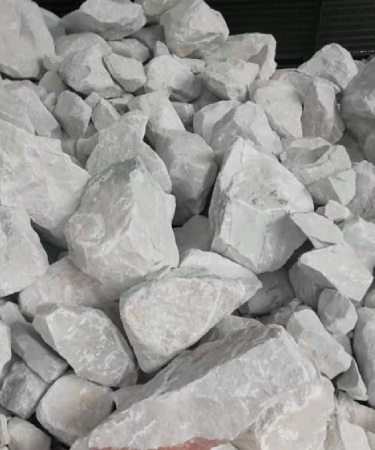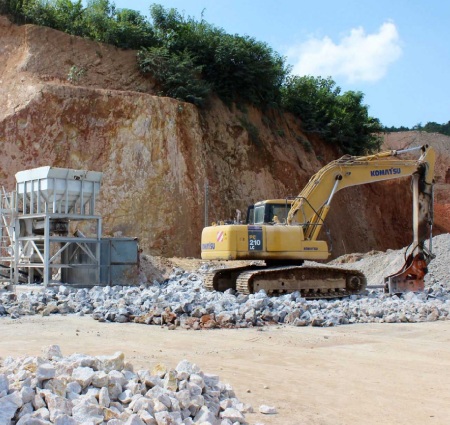White Barite Lumps
Barite lumps are natural minerals, one of the forms of Barium Sulfate (BaSO4), that look similar to sedimentary rocks. In fact, most of the Barite lumps are mined from layers of sedimentary rocks.
The Barite lump is available in a large quantity in depositional environments. It is deposited through a large number of processes including hydrothermal, biogenic, and evaporation. The Barite lumps are generally used in engine compartments for sound reduction, coat of automobile finishes for smoothness and corrosion resistance, radiation shielding cement and glass ceramics.

Specifications For High-quality Barite Lumps
|
Specific Gravity/Density |
4.43g/cm3 |
|
DV50µm |
15 |
|
Oil absorption |
14 |
|
BaSO4 (%) |
95 |
|
Fe2O3 (%) |
0.08 |
|
CaO (%) |
2.79 |
|
Al2O3 (%) |
0.71 |
|
SiO2 (%) |
0.15 |
|
Moisture |
0.07 |
|
PH Value |
8 |
|
Whiteness (%) |
98 |
|
MgO |
0.4 |
Grades Of Barite
Generally, there are three grades in Barite lumps: 4, 4.1, and 4.2.
The more the specific gravity, the higher the quality you get. The Barite lumps with high specific gravitational properties are suitable for a wide range of applications in medical, industrial, and manufacturing fields.
Barite Lumps Grade 4.20sg
The purity of Barite lumps with grade 4.20SG ranges a minimum of 90% BaSO4 concentration.
Barite Lumps Grade 4.10sg
The purity of Barite lumps with grade 4.20SG ranges a minimum of 80-90% BaSO4 concentration.
Barite Lumps Grade 4.0sg
The purity of Barite lumps with 4.20SG ranges a minimum of 60-70% BaSO4 concentration.

HOW DO WE GET BARITE?
Since the Barite lump provides more benefits such as strong inertia, good stability, acid and alkali proof, moderate rigidity, high specific gravity, high whiteness, and absorption of harmful radial, it is handled with care in the production unit. The production process includes:
- Open-pit Barite mining
- Crushing Barite ores
- Hydro-classifier flotation
Open-pit Barite mining
- Barite ores are drilled and collected as large mineral veins and beds.
- In the beginning stage, the ores are generally of low grade.
Crushing Barite ores
- This takes approximately 8 to 10 hours for a 24-hour operation.
- The ore is dumped over a 10” grizzly ahead of the coarse ore bin to classify the size of the pieces handled by the crusher.
Hydro-classifier flotation
- Barite ores are separated and concentrated by altering the surfaces to hydrophobic and hydrophilic conditions.
- It is much required to meet the market specifications.
- Finally, the Barite lumps are classified and moved for packaging.
Barite Reserves In India
As per the NMI database, based on the UNFC system, the total reserves of Barite was 86.67 million tonnes in the year 2015. By grades, 64% of resources are of Oil-well drilling grade, 6% of Chemical grade, 1% of Paint grade, and 27% constitute low grade.
It was found that over 92% of the country’s Barite resources are reserved in the states of Andhra Pradesh. As per the reports of the National Data Sharing and Accessibility Policy (NDSAP), the deposits of Barites are located at Mangampeta at Vemula in Andhra Pradesh & Telangana, Relpataliya in Rajasthan, Ghatihosahali in Karnataka, and Sukwari in Madhya Pradesh.
Applications Of Barite Lumps
Since Barite has various advantages and properties, the lumps are widely used in electronics, automobiles, rubber, TV screen, and paint industries. It is also used in glass products as a clarifying agent.
Barite Lumps are used in the form of powders in oil and gas exploration for drilling fluids. The properties like non-corrosive, non-abrasive, insolubility in water, and inertness make Barite a weighting agent in drilling operations. Since Barite has high-specific gravity, it is used in substantial tonnages to increase the density of water-based drilling. In fact, BIS (Bureau of Indian Standards) prescribed Barite lumps for the chemical and Oil-well drilling industry.
The major chemicals obtained from Barite are carbonate, chloride, hydroxide, nitrate, peroxide, sulfate, and oxide. In chemical industries, Barite lumps are mixed with ferric oxide and strontium sulfate limited to a maximum of 1%, and fluorine to traces.
Barite lumps are used as filler and extender in paint industries. White pigments are manufactured from Barite. In the paint industry, Barite is used in the form of dry powders. It should be free from mud, clay, and siliceous minerals.
Barite lumps are used as a filler extender in rubber products. The lumps are added to the rubber compounds to impart durability and resiliency. BIS (Bureau of Indian Standards) prescribed Barite lumps for use in the rubber industry.